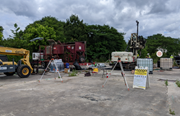Risks and Opportunities in Today’s Environmental Services Industry: A CEO’s Perspective
Today’s environmental services industry is full of both challenges and opportunities. For environmental consultants, there’s a real chance to grow and succeed by diversifying services, embracing new technology, and focusing on developing a strong workforce.
Cascade's CEO, Ron Thalacker, recently shared his perspective on the forces shaping the environmental services industry. With his experience leading the country's largest provider of integrated environmental drilling, site characterization, and remediation services, Ron is well-positioned to provide insights into the industry's direction.
Positive Influences on the Environmental Services Industry
The environmental services industry is strong and poised for continued growth.
Legislative Stimulus
We've seen a lot of positive changes thanks to significant legislative funding. The American Rescue Plan Act, Infrastructure Investment and Jobs Act, and Inflation Reduction Act are pouring money into clean energy, geotechnical work, environmental investigations, and infrastructure remediation projects. For example, the Infrastructure Investment and Jobs Act is modernizing our outdated infrastructure, making it more resilient to climate change and boosting sustainable transportation. The American Rescue Plan Act has been a lifeline for community health and environmental resilience, particularly in areas that have been underfunded. It's helping with essential projects like replacing old lead pipes and upgrading water systems. Meanwhile, the Inflation Reduction Act is pushing the adoption of green tech and renewable energy, nudging us towards a low-carbon future. Thanks to these funds, we wrapped up several federal remediation projects in 2023, and we have a solid pipeline lined up for 2024 and 2025.
Rising Workforce and Educational Opportunities
The environmental services industry is attracting young professionals, and educational institutions are stepping up with new credentialed and degree programs. Jobs for environmental scientists and specialists are expected to grow by 6% from 2022 to 2032, which is faster than the average for all occupations. More undergraduate, graduate, and certificate programs in environmental fields, including sustainability, are popping up. Millennials and Gen Z are drawn to work that aligns with their social values, like tackling climate change and its impacts. This growing interest in the field is helping us build a pipeline of passionate, qualified professionals ready to make a difference.
Sustainability Consultancy
Demand for sustainability and ESG (environmental, social, and governance) consultancy stretches across a wide variety of industries and interests. Companies need to navigate stricter supply chain screening, expectations for social responsibility, risk management, and transparency in governance and they’re turning to professional services for support. Environmental services firms are uniquely positioned to understand and provide these support services. With regulations like the SEC’s climate disclosure rule, public companies are under pressure to know their carbon footprint, set reduction goals, and report their progress publicly. This growing need for consultancy is a big opportunity for our industry.
PFAS Remediation
The waiting game on PFAS regulation is over. The EPA has rolled out a comprehensive plan that includes new regulations and reporting requirements under several frameworks, including the Safe Drinking Water Act, CERCLA, RCRA, TSCA, EPCRA, and the Clean Water Act. Companies that are potentially responsible need to work with environmental services firms to manage risks and limit their liability. The new CERCLA regulation, effective July 2024, makes polluters pay for investigations and cleanup, which ramps up the demand for investigative and remediation services.
Negative Influences on the Environmental Services Industry
Not everything is upside. These days, the environmental services industry faces several challenges.
Lack of Interest in Skilled Trades and Field Labor
Succession planning and workforce diversity are on the minds of many in the industry. While there's a growing number of environmental professionals eager to make their mark, the skilled trades and field labor needed for environmental work are lagging. Retirement is taking a toll on the skilled workforce, and the competition for talent is intense. Women still lag behind men in STEM fields like environmental services, both in workforce representation and in salaries. Many companies are struggling with high turnover and balancing remote versus on-site work in the post-COVID era.
Climate Change Resiliency
Climate change is both creating and complicating work for environmental services firms. Severe weather can wreak havoc on remediation sites and delay projects. Successful past remediation efforts need revisiting due to climate impacts. Hundreds of Superfund sites are at risk of destabilizing and releasing toxic chemicals. Over half of the nonfederal National Priorities List sites are in areas vulnerable to flooding or other climate impacts. While alternative energy sources like offshore wind offer promise, many projects are getting canceled or delayed because of rising costs and profitability concerns.
Economic and Regulatory Pressures
The economy is throwing us some curveballs, too. Inflation is pushing up costs for everything - employee benefits, wages, materials, and services. This makes it tough for companies to stay profitable and competitive in the labor market. High interest rates are also hitting hard, making it more difficult for businesses to finance growth and infrastructure upgrades. Companies have to strike a balance between managing costs and investing in crucial areas like technology and workforce development.
Clean energy regulation like California’s Advanced Clean Fleets (ACF) Regulation adds another layer of complexity. The ACF, for example, requires fleets to phase in Zero-Emission Vehicles (ZEVs) and mandates that manufacturers produce only ZEV trucks starting with the 2036 model year. It’s currently tied up in court. The legal uncertainty makes it hard for companies to meet decarbonization goals with their traditional fleet assets. This regulation is pushing the industry towards sustainability, but it also creates immediate financial and operational challenges for many companies.
Key Opportunities for the Environmental Services Industry
The industry has several key opportunities to embrace change, take advantage of technology to innovate and increase efficiency, and invest in their own success.
Diversify Revenue Streams
Looking ahead, it’s crucial to diversify beyond government-funded projects because the regulatory landscape can shift with the election cycle. Companies should explore new areas and partnerships isolated from government funding and regulations. Proactive environmental risk management can create new revenue streams and align with current trends, preparing companies for future market changes.
Embrace Technology
There are two ways environmental service companies should think about using technology for growth: business operations and field implementation. Advanced technologies like AI can make processes more efficient and reduce costs by automating routine tasks like design documentation, sampling, performance data analysis, and proposal writing. This allows environmental consultants to focus on higher-value activities. New remediation technologies are also making a big impact. For example, automated in situ injection systems, such as Cascade’s Pathfinder™ technology, reduce errors in data logging and improve precision in remediation efforts. These tech advancements not only boost project outcomes but also cut costs and operational risks, helping firms meet the growing demand for effective remediation.
Cybersecurity is a must-have in today’s tech-driven industry. As we digitize more, the risk of cyber threats grows, so we need strong measures to protect our data and operations. Advanced solutions like zero-trust architectures and thorough employee training are crucial. Ensuring technology investments align with business needs is vital, too. As Cascade’s Chief Information Officer John Michael Gross points out, every tech solution should address a clear business need to ensure resources are used effectively and drive real benefits. This strategic approach helps firms stay resilient and adaptable to future challenges.
Workforce Development
Building a strong workforce is key to staying competitive in the environmental services industry. Investing in training and development ensures that companies can meet the growing demands for environmental services and tackle the challenges that come with them. Comprehensive training programs for all levels of management, including leadership development, are essential to equip employees with the skills they need. Offering competitive compensation packages that go beyond traditional wages and benefits can attract and retain top talent. Non-traditional benefits like pet-friendly offices, childcare assistance, and flexible work schedules can also boost employee satisfaction and retention. Engaging employees through thorough onboarding, regular performance reviews, pulse surveys, and recognition programs helps build a motivated and loyal workforce.
Succession planning is another important part of workforce development. Creating formal succession plans to identify and develop future leaders from within is crucial. A strong organizational culture can attract Millennials and Gen Z professionals, who value a sense of purpose and belonging. By providing an engaging work environment, companies can appeal to younger professionals and address the challenges of an aging workforce. Continuous development and aligning company values with those of the emerging workforce will help build a resilient and capable team ready to meet the industry's future needs.
The environmental services industry is an exciting field right now. While there are challenges to address, there are also huge opportunities to diversify services, leverage technology, and grow a strong workforce.
To keep up with the latest industry updates, subscribe to Cascade's newsletter, Pathways. It delivers news, expert advice, and real stories from the field straight to your inbox.












